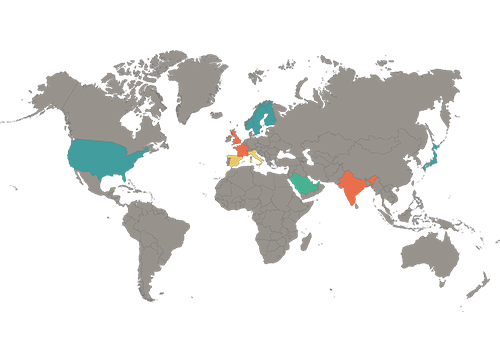Data and AI Sovereignty
Secure. Compliant. Locally controlled. Build your AI with the infrastructure and
data sovereignty you need to lead in a digital-first world.
What is sovereign AI?
Sovereign AI refers to the creation, deployment, and governance of artificial intelligence systems within frameworks that prioritize data sovereignty, regulatory compliance, and infrastructure control. It means owning every layer of the AI stack from localized data storage to independent model orchestration.
True data and AI sovereignty means you can access, manage, and control your data, wherever, whenever, and however you want to use it—securely and compliantly, across clouds and your premises. When these conditions are met, enterprises can scale AI with full visibility, consistent governance, and zero dependency on external control points.
It’s the difference between adapting to your AI and having it adapt to you.
Why data and AI sovereignty is a strategic priority today
As enterprises move from generative AI to agentic AI, the infrastructure behind these systems becomes even more critical. Agentic AI doesn’t just generate outputs; it takes action, reacts to inputs, and spans multiple environments. That makes governance, visibility, and compliance far more complex—and more urgent.
In EDB’s global research, 95% of senior executives said building their own sovereign AI and data platform will be a mission-critical priority within three years. The drivers are operational: enforcing regulatory alignment, securing proprietary data, and deploying AI across hybrid infrastructure without compromising oversight or integrity.
Data sovereignty is the foundation. Hybrid AI infrastructure is the design. Sovereign AI is the outcome.

Global momentum toward sovereign AI
More than 10,000 enterprises a year are committing to sovereign AI and data platforms.
Explore the data: which countries are ahead, what’s driving urgency, and how the race is shifting global enterprise strategy.

Benefits of sovereign AI and data sovereignty
Enforce regulatory compliance from the start
Meet evolving global and local requirements—including GDPR, HIPAA, and the EU AI Act—with architecture designed for auditability and policy enforcement at every layer.
Protect sensitive data and models by design
Safeguard proprietary data, intellectual property, and AI models using zero-trust access controls, advanced encryption, and privacy-first infrastructure.
Control your deployment model
Run AI where it makes sense—on-premises, in sovereign clouds, or in hybrid environments—without compromising control or compliance.
Break down silos across data and teams
Unify structured and unstructured data across systems, enable cross-functional collaboration, and make your AI systems more context-aware and actionable.
Adapt infrastructure without vendor lock-in
Build on open standards with full interoperability across clouds, databases, and deployment models—giving you control over costs, flexibility, and performance.
Accelerate time to value with agentic AI
Support low-code/no-code workflows and real-time analytics, so domain experts can build and deploy AI without bottlenecks.
Sovereign AI data infrastructure and architecture overview
Unified data and AI layers
A sovereign platform brings data and AI together into a single operational architecture. This ensures models are trained, deployed, and governed alongside the data they rely on—enabling stronger observability, faster adaptation, and fewer silos.
Built-in regulatory alignment
From GDPR to HIPAA to the EU AI Act, sovereign platforms must enforce compliance from the foundation up. That means automated controls for data locality, retention, and access, backed by audit-ready transparency.
Hybrid-by-design architecture
Sovereign AI depends on flexible deployment. The platform must span cloud, on-prem, and edge environments without losing security, performance, or governance. It must also integrate with sovereign cloud providers where necessary—without creating lock-in.
Open and extensible technologies
Proprietary stacks can’t deliver true sovereignty. Enterprises need open source technologies with enterprise-grade support—tools that are portable, standards-based, and proven to scale. Postgres is emerging as a strategic foundation in this shift.
Operational observability and control
AI introduces complexity that demands deep visibility. Sovereign platforms must offer real-time insights into data lineage, model behavior, policy enforcement, and system health—so teams can act confidently and compliantly at every stage.
Additional resources
Empowering Data Sovereignty and AI Innovation at Supercomputing 2024
EDB Postgres AI Use Case: Sovereign AI
Sovereign AI: Achieve Generative AI Innovation with Control, Security, and Speed
Sovereign AI refers to the creation, deployment, and governance of artificial intelligence systems within frameworks that prioritize data sovereignty, regulatory compliance, and infrastructure control.
For example, the sovereign AI solution with EDB Postgres AI, AI Factory, allows businesses to maintain full control over their data and AI operations by bringing GenAI models to a secure Postgres environment—providing flexible deployment options, enhanced security, and cost efficiency without relying on cloud-based services.
AI Factory provides the fastest way to test and launch enterprise GenAI inference applications with the powerful EDB Pipelines extension that comes preloaded with pgvector—providing automated vector embedding, storage, and retrieval workflows directly in Postgres. This allows developers to achieve complex GenAI functionality with minimal code. With swappable configurations, businesses can easily adapt to various needs by switching models and integrating multiple data modalities, while automated pipelines ensure always-up-to-date data for efficient query and retrieval.
Sovereign AI uses a model-to-data approach, enabling GenAI inference from well-governed data in Postgres without exposing sensitive information to cloud-based models. EDB Postgres AI also comes with robust security features like RBAC and encryption at rest and in transit. This eliminates data movement and ensures compliance with data privacy regulations.
Key features include:
A private AI environment where GenAI models run close to well-governed data in Postgres with full observability and audit logging.
Deployment options across on-prem, private cloud, or hybrid infrastructure to suit your business needs.
Access controls and encryption features such as RBAC, RLS, TDE, and more.
Locally hosted open source models that eliminate vendor lock-in and cloud fees.
Yes. EDB Postgres AI’s integration with open lakehouse tables in object storage allows for seamless incorporation of data into GenAI applications without requiring multiple databases or performance-degrading data pipelines.
Sovereign AI offers:
Full control of data for stronger governance
Greater flexibility to meet shifting market, regulatory, and operational demands
Enhanced security and compliance for minimized risk
Cost optimization via 5x cost-efficient formats and eliminating vendor lock-in
While beneficial for many industries, sovereign AI is particularly valuable in sectors such as finance, healthcare, and government, where data security and compliance are critical and heavily regulated.
EDB Postgres AI provides a unified sovereign AI platform for storing, managing, and interacting with your data, serving as an ideal AI base layer that won’t require future changes. This approach keeps AI simple and under your control. It enables rapid deployment of customizable AI by allowing businesses to swap models with minimal code, instantly adapt to changing business needs, and implement AI across different business units seamlessly.
With full control over deployment and resource management, sovereign AI reduces costs by avoiding cloud data access fees, optimizing storage, and enabling scalable AI solutions—ensuring maximum return on investment.
Yes, sovereign AI addresses the velocity-vigilance tradeoff by enabling rapid AI integration while maintaining secure, stable, and observable data in business operations.